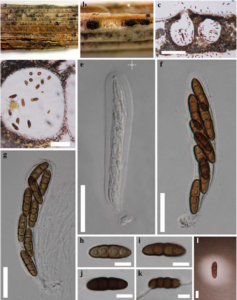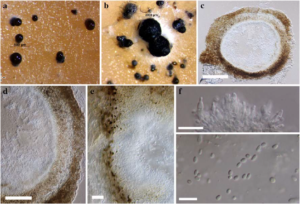Kalmusia italica Thambugala, Camporesi & K.D.Hyde.
Index Fungorum number: IF550915, Facesoffungi number: FoF00388, Figs. 1 and 2
Etymology – in reference to its occurrence in Italy.
Holotype – MFLU 14–0620
Saprobic on branches of Spartium junceum. Sexual morph Ascomata (140–)200–300 μm high × 150–280 μm diam. (x̄ = 214 × 198 μm, n=10), gregarious or grouped, immersed to semi-immersed, dark brown to black, uniloculate, globose to subglobose, medium to large sized and coriaceous, fusing with the host tissue, with a central ostiole. Peridium 10–20μm wide, comprising a few layers of dark brown to lightly pigmented cells of textura angularis. Hamathecium comprising 1–2μm wide, dense, cellular, hyaline, aseptate, pseudoparaphyses, anastomosing above the asci, embedded in a gelatinous matrix. Asci 90–135×14–20μm (x=107.5×17.7μm, n=15), 4–8-spored, bitunicate, fissitunicate, cylindro-clavate to clavate, pedicellate, apically rounded with a small ocular chamber. Ascospores 21–27×6–8.6μm (x=23×7.2μm, n=25), overlapping 1–2-seriate, fusoid to fusoid-ellipsoidal, with broadly to narrowly rounded ends, pale brown to dark yellowish-brown, 3-septate, strongly constricted at the septum, with verruculose ascospore wall surrounded by mucilaginous sheath. Asexual morph Pycnidia solitary, gregarious or grouped, superficial on PDA, ostiolate. Pycnidial wall up to 50–90μm wide, comprising several layers of pseudoparenchymatous, cells of textura angularis and textura prismatica, the outer layer composed of thick-walled, dark brown cells, lighter towards the inner layers of hyaline cells. Conidiogenous cells 3.4–6.2×2–3.5μm (x=4.8×3.1μm, n=20), short cylindric, conidiogenous holoblastic, hyaline, smooth. Conidia 1–1.5×2–3.4μm (x=1.2×2.9μm, n=25), oblong, ellipsoid-cylindric, aseptate, hyaline to lightly pigmented, smooth-walled.
Culture characters– Ascospores germinating on PDA within 18 h and producing germ tubes from both ends. Colonies growing slowly on PDA MEA, reaching a diam. of 30 mm after 9 d at 25 °C, flat, surface smooth to velvety, with entire edge, white, fairly dense, filamentous; reverse white to pale white, non-pigmented.
Material examined – ITALY, province of Forlì-Cesena [FC], Montebello, Modigliana, on dead branch of Spartium junceum L. (Fabaceae), 14 October 2012, E. Camporesi, IT827 (MFLU 14–0620, holotype), ex-type living cultures, MFLUCC 13–0066. ibid., (PDD, isotype).
GenBank Accession Numbers – MFLU 14–0620: ITS:KP325440; LSU:KP325441; SSU: KP325442;
Notes– Kalmusia was introduced by Niessl (1872) based on K. ebuli Niessl and is characterized by immersed to erumpent ascomata, filiform, delicate, septate pseudoparaphyses, bitunicate, clavate asci with narrowly ovoid to clavate, pale brown, 3-septate ascospores. Kalmusia has been reported to have coniothyrium-like, Cytoplea, Microsphaeropsis and Paraconiothyrium asexual morphs (Zhang et al. 2012a; Ariyawansa et al. 2014b; Zhang et al. 2014). Kalmusia italica is distinct from K. ebuli in having aseptate pseudoparaphyses, asci with short pedicel and a mucilaginous sheath.

Fig. 1 Kalmusia italica (holotype) a, b Ascomata on host surface c Section through ascomata d Peridium e Immature ascus f, g Mature bitunicate asci (note the pseudoparaphyses in g) h–j Ascospores k Germinating ascospore l Ascospore stained with Indian ink. Scale bars: c = 200 μm, d = 50 μm, e–g = 25 μm, h–l=10 μm.

Fig. 2 Kalmusia italica Asexual morph (ex-type culture). a, b Pycnidia on MEA c Section of pycnidia d Pycnidial wall e, f=Conidiogenous cells and developing conidia g Conidia. Scale bars: c=200μm, d=100μm, e-f=15μm, g=10μm.
